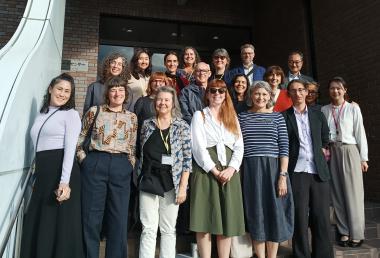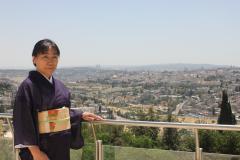-
 With the establishment of the International Joint Digital Archiving Center for Japanese Art and Culture (ARC-iJAC) in 2019, the Art Research Center strives to push the internationalization of research activities that transcend disciplines and geographic boundaries.
With the establishment of the International Joint Digital Archiving Center for Japanese Art and Culture (ARC-iJAC) in 2019, the Art Research Center strives to push the internationalization of research activities that transcend disciplines and geographic boundaries.NEWS
We express our sincere gratitude to HIH Princess Akiko of Mikasa who gave a talk on 'A Tale of the Royal and Imperial Households: The Trajectory of UK-Japan Relations' on October 23 as part of the International ARC Seminar series.
Furthermore, we were delighted to welcome members of the Art Libraries Society of North America (ARLIS/NA) to the ARC who visited us as part of the society's first study tour to Japan.


Striving to contribute to achieving peace through Japanese art, Dr. Kameda-Madar talks about the Japanese art collection held by the Hebrew University of Jerusalem and her related ARC-iJAC project to digital archive this collection. >> Read more. 
A database containing 650 Sugoroku items, representing about 500 different kinds of Sugoroku game boards dating from the Edo period to the early 1950s, collected by Osamu Yoshida, President of the Tsukiji Sugoroku Museum, has been released in the ARC Database System. >> Read more.
>> Database.We are pleased to announce the launch of the new Shahon Mokuroku 写本目録/Manuscripts (Bibliographic) Database, which includes over 3,400 bibliographic records for Japanese handwritten manuscripts held by the C. V. Starr East Asian Library, University of California, Berkeley. >> Read more.This database can be accessed through the Library's Japanese Special Collections portal provided by the ARC.

 On September 10 and 11, 2024, the British Museum and the ARC-iJAC jointly hosted a symposium at SOAS University of London as part of the 3-year international joint research project 'Creative Collaborations: Salons and Networks in Kyoto and Osaka 1780-1880 (上方文化サロン:人的ネットワークから解き明かす文化創造空間 1780-1880),' supported by UK Research & Innovation (UKRI) and the Japan Society for the Promotion of Science (JSPS). >> Read more.
On September 10 and 11, 2024, the British Museum and the ARC-iJAC jointly hosted a symposium at SOAS University of London as part of the 3-year international joint research project 'Creative Collaborations: Salons and Networks in Kyoto and Osaka 1780-1880 (上方文化サロン:人的ネットワークから解き明かす文化創造空間 1780-1880),' supported by UK Research & Innovation (UKRI) and the Japan Society for the Promotion of Science (JSPS). >> Read more.
A Special Display, showcasing the outcomes of this joint research project, is up at the British Museum until March 2025. >> Details.
A digital archive of Takemoto yukahon theatrical chanters' books has been released as part of the FY 2024 ARC-iJAC project '演劇上演記録データベースを活用した、演劇資料画像検索閲覧システムの構築に関る研究.' >> Read more.
>> Database.The National Diet Library's Historical Recordings Collection (Rekion) is available at the ARC
We are pleased to announce that we offer access to the National Diet Library's Historical Recordings Collection (Rekion) streaming service as one of its partner institutions.
If you would like to listen to the recordings at the ARC, please refer to the link below for the application process.
→ https://www.arc.ritsumei.ac.jp/e/application/New! Recommended Publications by ARC-Affiliated Reseachers
'Salon culture in Japan: making art, 1750−1900' (hardback)
by Akiko Yano (editor/ARC Visiting Collaborative Researcher)
Publisher: British Museum Press
ISBN: 9780714124964
'Fashion and the Floating World: Japanese ukiyo-e Prints' (hardback)
by Anna Jackson (author) and Masami Yamada (author/ARC Visiting Collaborative Researcher)
Publisher: V&A Publishing
ISBN: 9781838510503Upcoming Events
November 20-22, 2024, 10:00-17:00 JST
Exhibition '手書き映画ポスターと看板の世界'
第三回 ~松竹蒲田撮影所制作作品より~
Venue: Multi-Purpose Room, Art Research Center, Kinugasa Campus, Ritsumeikan University
Free entry.
November 27 (Wed), 2024, 18:00-19:30 JST
141. International ARC Seminar
Speaker: Eiji ARAKAKI (City History Editorial Team, Nanjo City Board of Education, Cultural Division)
Topic: The Digital Archiving Project in Nanjo City, Okinawa (held in Japanese)
Live stream available via >> YouTube.


Previous issues:
Summer 2024, Spring 2024, Winter 2023, Autumn 2023, Summer 2023, Spring 2023, Winter 2022, Autumn 2022, Summer 2022, Spring 2022, Winter 2021, Autumn 2021, Summer 2021, Spring 2021, Winter 2020, Autumn 2020, Summer 2020, Spring 2020view this email in your browser Copyright © 2024 Art Research Center, Ritsumeikan University. All rights reserved.
Our mailing address is:
56-1 Toji-in Kitamachi, Kita-ku, Kyoto 603-8577 JAPAN
Want to change how you receive these emails?
You can update your preferences or unsubscribe from this list.
2025年3月22日(土)に、第14回「知識・芸術・文化情報学研究会」を開催いたします。
それに伴い、発表者の募集をいたします。奮ってご応募ください。→発表申込みフォーム
またこの会は、ARC-iJACの若手研究者カンファレンスとして位置付けられています。
「知識・芸術・文化情報学研究会」について
昨今のデジタル・情報環境の急速な進展とともに、学術分野にも「情報」や「デジタル」を意識した分野横断型の研究が多く見受けられるようになってきました。大学の教育・研究活動においても、この傾向は強まっており、これに関連する教育プログラムやコースの活動が充実しています。
時代に即した新しい研究テーマのもと、このような課程で学ぶ学部生・大学院生や若手研究者が学術的な交流をする機会へのニーズはますます大きくなっています。
そのため、芸術・文化、およびその他の関連する分野の情報・知識研究に興味のある大学院生および若手研究者を主に意識し、発表・交流のための場として「知識・芸術・文化情報学研究会」を2011年度に発足させ、これまで13回の研究集会を開催しました。
本会は、異分野の人的交流を通じて、参加者相互が新たな研究テーマや方法を発見できる場と位置づけており、学会発表とはひと味違う萌芽的・冒険的な発表も歓迎します。開催日および実施方法
開催日:2025年3月22日(土)
会場:立命館いばらきフューチャープラザ カンファレンスホール(立命館大学 大阪いばらきキャンパス内)
〒567-8570 大阪府茨木市岩倉町2-150 (https://www.ritsumei.ac.jp/futureplaza/conferencehall/)※時間は発表者数により調整します。
※「対面およびオンライン(Zoom)によるハイブリッド方式」または「完全オンライン開催(Zoom)」となる可能性があります。研究分野
1. 情報技術を使った芸術・文化分野やその他の分野の研究
2. 芸術・文化やその他の分野に応用できる情報技術の研究研究発表の内容例
1. 芸術分野やその他の分野の情報・知識の構造解析、モデル化、可視化、知識発見
2. 芸術分野やその他の分野の情報・知識の表現、生産、組織化・DB構築、検索、提供
3. 電子出版、電子図書館、電子博物館・美術館
4. 芸術分野やその他の分野の用語、シソーラス
5. 芸術分野やその他の分野の情報・知識の流通と知的所有権
6. オープンデータ、データパブリッシング、リンクトデータ
7. インターネット、セマンティックウェブ、Web x.0 など
8. その他、広く文化を対象とした情報・知識に関連する諸研究・開発応募方法
2025年2月3日(月)までに、発表申込みフォームよりお申し込みください。発表時間:質疑込み20分程度。ただし発表者数により調整する。(発表時間および発表資料提出の要領は締め切り後、発表者に連絡します。)
※参加費は無料です。
※なお、研究発表会後に懇親会を予定しています。主催:知識・芸術・文化情報学研究会
世話役〔五十音順〕:赤間亮(立命館大学)、阪田真己子(同志社大学)、田窪直規(近畿大学)、村川猛彦(和歌山大学)、山西良典(関西大学)
共催:情報知識学会関西部会、アート・ドキュメンテーション学会関西地区部会
協力:立命館大学アート・リサーチセンター 文部科学省 国際共同利用・共同研究拠点「日本文化資源デジタル・アーカイブ国際共同研究拠点」■問い合わせ:kacimeeting+2025■gmail.com (■を@に変えて下さい)
「海月書屋」が所蔵する明治末から昭和期の、歌舞伎を中心とする役者絵葉書・ブロマイド類約1,850点がデジタル化され、一般公開されました。
海月書屋絵葉書データベース
https://www.dh-jac.net/db/butai-photo/search_kgt.php催事型写真ポータルサイトからも閲覧することができます。
https://www.dh-jac.net/db/butai-photo/search_portal.php
本コレクションは、役者個人の写真が中心です。役者の名前や代数、演目名、制作年代などから検索することができます。一般的な歌舞伎絵葉書のほか、役者の顔を絵で描いた絵葉書、小芝居の役者、映画俳優、絵葉書・ブロマイドの袋(販売店名入り)等を含む貴重なコレクションです。
銀座上方屋製で、明治末から大正初年頃の、役者の顔貌のみを拡大撮影した絵葉書100枚(帝国劇場の女優や新派役者も含む)を収容する特製アルバム「百面相絵はがき帖」も登載されています。
今後も引き続き、正確なメタデータを追加していきます。データの誤りや未記載の情報等についてお気づきの点がありましたら、お知らせいただけますようご協力をお願いします。

2024年10月28日、北米美術図書館協会(Art Libraries Society of North America・ARLIS/NA)のメンバーが、初の日本スタディ・ツアーの一環として、アート・リサーチセンター(ARC)を見学されました。
アメリカやカナダの美術図書館や大学図書館に所属する16名ほどの参加者は、ARCの建物や施設を見学されたほか、赤間亮教授(文学部・教授/ARCセンター長)とTravis Seifman氏(立命館大学衣笠総合研究機構・准教授/現ARCリサーチマネージャー)とデジタル人文学に関する相互連携について意見交換を行いました。
2024年11月13日(水)18:00より、Web配信にて第140回国際ARCセミナーを開催いたします。
プログラムは下記となります。
講師:中村 覚氏(東京大学史料編纂所・助教)
タイトル:「東京大学史料編纂所における史料編纂・歴史研究支援に関する取り組み」
日時:2024年11月13日(水)18:00~19:30
参加:Zoom配信(関係者のみ・予約不要)
※ARCメンバー以外の方は Youtubeよりご参加いただけます。こちらからご覧下さい。
赤穂市「忠臣蔵」浮世絵デジタル展示室:
https://www.arc.ritsumei.ac.jp/lib/vm/akochushingura/赤穂市とアート・リサーチセンターが共同で進めている「忠臣蔵」浮世絵のオンライン展示の第四弾「ユニークな忠臣蔵あれこれ」を公開しました。
https://www.arc.ritsumei.ac.jp/lib/vm/akochushingura/
「忠臣蔵」は、日本人であればだれもがそのストーリーを熟知する物語でした。だれもが知っている物語であればこそ、浮世絵師たちは豊かな発想力をもって工夫を凝らし、ユニークな作品を生み出しました。
本展示では、その発想力豊かな作品をさまざまな切り口で紹介しています。実際の芝居の豪華な演出を反映させたものや、「仮名手本忠臣蔵」全段を1つの画面に巧みにまとめて描いたもの、洋風表現を取り入れたもの、読み解くのに相当の知識量を求められる見立絵、見れば思わず吹き出してしまいそうな戯画や擬人絵、子どもに限らず大人も十分楽しめるおもちゃ絵など、その多彩な作品世界はまさに「忠臣蔵文化」の広がりを具現化しているといっても過言ではありません。
是非とも、サイトに訪問いただき、そのバラエティに富む表現をお楽しみください。
第4回展覧会「ユニークな忠臣蔵浮世絵あれこれ」がオープンになりました。
これまで、赤穂市では、アート・リサーチセンターの電子展示システムを活用して、3回のデジタル展覧会を実施してきました。第四回目となる今回は、役者絵・芝居絵・物語絵・武者絵にとどまらない、だれもが知っている物語であればこそ浮世絵師たちが豊かな発想力をもって工夫を凝らしたユニークな68作品を、さまざまな切り口で紹介し、解説します
実際の芝居の豪華な演出を反映させたものや、『忠臣蔵』全段を1つの画面に巧みに描いたもの、洋風表現を取り入れたもの、読み解くのに相当の知識量が求められる見立絵、見れば思わず吹き出してしまいそうな戯画や擬人絵、子どもに限らず大人も十分楽しめるおもちゃ絵など、その多彩な作品世界はまさに「忠臣蔵文化」の広がりを具現化しているといっても過言ではありません。
浮世絵師が趣向を凝らし、それを庶民が喜んで享受した多種多様な忠臣蔵浮世絵をどうぞご堪能ください。
赤穂市「忠臣蔵」浮世絵デジタル展示室
https://www.arc.ritsumei.ac.jp/j/report/v_museum/
赤穂市「忠臣蔵」浮世絵データベース
https://www.dh-jac.net/db/nishikie/search_ako.php
赤穂市HPからの入り口
https://www.city.ako.lg.jp/edu/shougai/akoukiyoedatebase.html[イベント情報]2024年11月 6日(水)Background:
Kazuko Kameda-Madar completed her PhD in Japanese Art History at the University of British Columbia in 2011. She has taught at the University of Hawaiʻi at Mānoa, University of Hawaiʻi - West Oʻahu, and Hawaiʻi Pacific University for many years. Currently, she holds the position of Visiting Professor of Japanese Art History at the Hebrew University of Jerusalem in Israel (HUJI). She is also a Visiting Researcher at the Art Research Center, Ritsumeikan University. Her research interest is in Edo-period Japanese art and visual culture based on Chinese pictorial themes and episodes, especially visual representations of the Orchid Pavilion Gathering that took place in 4th century China.
Her publications include Imagery of the Orchid Pavilion Gathering (Leiden: Brill, 2022); "An Iconology of the Orchid Pavilion Gathering: Image, Text, and Communities in Tokugawa-Era Japan" in The Tokugawa World (London: Routledge, 2021); and "Copying and Theory in Edo Period Japan" in Theorizing Imitation in a Global Context (London: Association of Art Historians, 2014). She is a co-editor of an anthology Power of Utsushi: Matrix of Creation and Continuity (Kyoto: Shibunkaku Press, 2014), and Sino-Japan Code and the Representation of Nature: Art and Literature of Japan in the 16th and 17th centuries (Tokyo: Bensei Press, 2019).Dr. Kameda-Madar, thank you very much for your time today. What sparked your interest in becoming a researcher in Japanese art history?

Kameda-Madar: Although I was always interested in art as a child in Japan, I took it more seriously when I began my formal education abroad - at the University of Hawaiʻi. Upon starting my studies, I realized how rich and wonderful Japanese art is, and I wanted to learn more about it. Prof. Mariko Inoue was my first mentor, greatly influencing my academic direction. I was fortunate to be surrounded by specialists in Chinese art. When I was seeking a topic for my MA thesis, Prof. James Cahill--who was in Hawaiʻi at that time--kindly introduced me to Prof. Hironobu Kohara in Kyoto. Under his guidance, I chose to study the theme of the Orchid Pavilion Gathering. This theme, which I believe embodies a strong, yet very subtle, implicit anti-war sentiment, captivated me, and I began to focus my research on the Sino-Japanese cultural relationship.
2024年11月6日(水)18:00より、Web配信にて、2024年度「AI解読支援システムを使った くずし字解読力錬成講座」の一環として、「国際ARCセミナー特別編」を開催いたします。
プログラムは下記となります。
講師:Ellis Tinios氏(リーズ大学名誉講師)
タイトル:「Understanding Edo period books as material objects and bibliographic entities」
本講演は英語で行われます。
日時:2024年11月6日(水)18:00~19:30
参加:Zoom配信(関係者のみ・予約不要)
※ARCメンバー以外の方は Youtubeよりご参加いただけます。こちらからご覧下さい。















